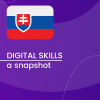IT Fitness Test broke records for 13th year in a row, with close to 200.000 people taking part

The Digital Coalition successfully completed the thirteenth year of the IT Fitness Test, which reached a historic record. Pupils and teachers from Slovakia, the Czech Republic, Hungary, Poland and Ukraine took part in the digital skills test. In Slovakia, 50,000 thousand pupils and almost 2,500 teachers took part in the testing, again achieving the best results in international comparison.
“We are particularly positive about the fact that every year the success of this project is confirmed, as evidenced by the record number of almost 190,000 tested pupils in all Visegrad countries. The success for Slovakia is that we obtained the highest percentage of student success in testing among all tested countries," said Mário Lelovský, President of the Digital Coalition.
The test was available in two versions – for primary and secondary schools – and in six languages, including English and Ukrainian. This year, in addition to general IT skills, testing also focused on verifying the ability to work with various AI tools. The event also included an award for teachers, classes and schools that achieved the best results and ranked in the top ten with the highest average.
“Despite the fact that this year’s results may have been influenced by a change in the test sample, a change in participation in individual countries or slightly more demanding tests with the addition of new topics, I consider Slovakia’s first place in both versions of the test to be a success. However, the tests also showed the need to continue working with young people, to develop cognitive abilities, to train critical thinking and to put an emphasis on reading comprehension, which is crucial for further lifelong learning," said Mário Lelovský.
Testing of digital skills confirmed their gradually increasing level among Slovak pupils. This year, more than 11,000 pupils from 622 schools participated in digital skills testing in Slovak primary schools. The Bratislava region defended its leading position with the best result - a success rate of 57.2%. At the same time, Slovak pupils achieved the best overall results among the participating countries, with an average success rate of 52.1%. In international comparison, Hungary ranked second (50.33%), the Czech Republic third (47.36%) and Poland fourth (45.11%). This success reflects the quality of the preparation of Slovak pupils and their growing skills in the field of digital literacy.
High school students were equally successful, with more than 39,000 of the 594 schools taking part in the tests. The best results among the regions were achieved by the Prešov region with a success rate of 50.1%, which again defended the first place in this category. This time again, Slovakia succeeded in the international ranking, with an average success rate of 44.52% for Slovak secondary school students. This was followed by the Czech Republic (38.81%), Poland (35.83%) and Hungary (34.60%). 2 426 teachers also passed the test, achieving an average score of 54.08%, confirming the importance of digital skills in education. The better results of secondary school students in Slovakia can also be attributed to the full equipment of second and third year pupils with computers for home study.
"At the Department of Informatisation, we believe that every child – regardless of their background – should have the opportunity to develop their potential," said Richard Raši, Minister for Investment, Regional Development and Informatisation. He added that after the Digital Pupil project, his department is catching up with an inclusive project called Social vouchers for internet connectivity for pupils. “Investing in equipping students with digital devices is essential and contributes to significantly improving children’s digital skills, as demonstrated by this testing,” concluded Raši.
Every year, the IT Fitness Test questions are prepared by a team of experts who focus on practical skills, reading comprehension and the ability to apply the acquired knowledge in real life. The test also tracks current digital trends, with results showing significant differences across categories. Respondents have traditionally led the way in working with the Internet. On the contrary, the largest reserves are manifested in pupils and students when working with office tools, structured data, tables and graphs. The challenge remains to solve more complex tasks, correctly evaluate the text and understand its context. Year-on-year, high school students deteriorated in the category of Security and Computer Systems.
“While a comprehensive year-on-year comparison is not possible due to a changing group of respondents and questions, trends remain constant. It confirms the need to continue to support the development of these skills, both in formal and non-formal education", stressed Lelovsky.
Experts agree on the importance of developing critical thinking and the ability to evaluate information – to assess its quality, credibility and veracity. The results of the international PISA testing show that Slovak pupils are lagging behind in these areas. The decline in mathematics and reading skills, where one in three students did not even reach the basic level, is particularly alarming. In 2025, one of the themes of PISA testing is learning in the digital world, confirming the need to focus on developing digital skills already in primary schools.
These findings underline the need to continue the digital transformation of the education system in Slovakia. Improving the quality of education and investing in the development of digital skills could help not only individuals but also society as a whole. Test results can provide governments with valuable data to take action to make young people more competitive in the global labour market.
"The ability of the population, especially young people, to navigate the online world, to critically evaluate the information available, while not forgetting digital security, is crucial for Slovakia's progress. Test results show Slovakia's potential to become a leader in digital technologies. However, the year-on-year deterioration of pupils in the Safety category poses a challenge at a time of dynamically evolving threats. In the case of digital pitfalls, it is generally easier to prevent them than to counter their consequences. That's why one of our long-term priorities is to educate the public in this area," said Pavol Holéczy, ESET EMEA Director.
One of the companies that supported the project is Cisco, which said: “We are happy to support the IT Fitness Test, which increases the digital literacy and skills of Slovak pupils. The record participation confirms the importance of this initiative for the future of the IT sector. As part of our programs, such as Cisco Networking Academy, we strive to develop not only technical skills but also to educate about cybersecurity. We believe that these initiatives prepare young people for a safe and digital future".






